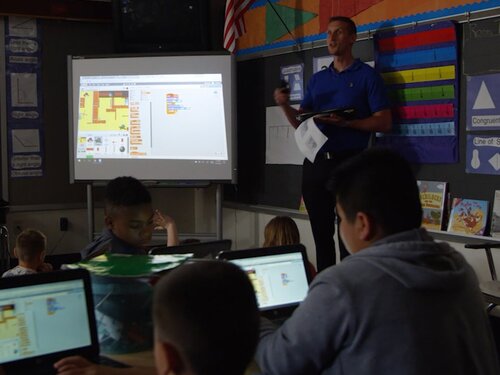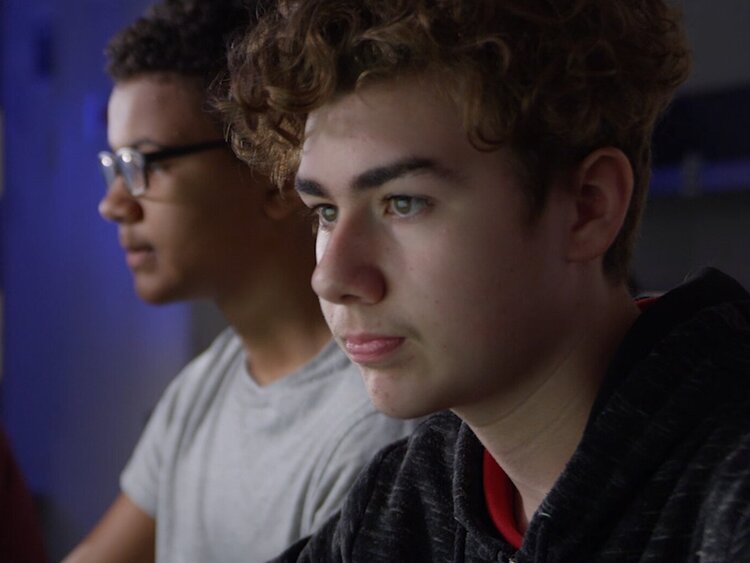
Begin with the End in Mind.

This phrase probably sounds familiar to you, especially if you’ve read the 7 Habits of Highly Effective People by Steven Covey. The meaning of the adage is clear: having a vision, mission, and direction can help you achieve even the most daunting tasks.
Beginning with the End in Mind can be helpful for curriculum implementation, as well. You may have been tasked to implement computer science standards – where do you begin? Setting a goal for the HOW can give you a benchmark for your progress and help you keep creating a great experience for 21st century learners.
Since Ellipsis Education is passionate about computer science, we wanted to share three different computer science implementation goals. Depending on where you are in your computer science journey, get set up for success!
Sample goal 1: Introduce students to computer science concepts using activities that are integrated into our core subjects.
Sample goal 2: Start teaching computer science to students once a week using free resources available online.

You might be wondering: where do I start with teaching computer science? Maybe time is tight during the school day; maybe you don’t have the budget for a computer science curriculum this year. Luckily, there are many free resources and activities available to learn basic computer science skills.
You might start by incorporating a computer science activity into one of your existing classes. In our Computer Science Education Week post, we outlined 5 ways to spark CS interest, including inviting a local speaker, introducing pair programming, and creating a class website. All of these activities could be integrated with a core subject, like science, math, or English.
Other options for free lessons include Code.org and our library of free eLearning lessons. Try them out in your classroom, and watch your future computer science learners discover their potential!
Sample Goal 1: Offer more computer science options for students by introducing one computer science course as a specials rotation.
Sample Goal 2: Integrate a full computer science curriculum with other core subjects during the school day.
It’s no secret that free computer science resources run dry. What do you teach your students once you’ve completed all the available activities?
Whether you integrate lessons into core subjects or in a specials rotation, it’s important to introduce students to fundamental computer science concepts that build upon one another. Instead of one-off lessons, try incorporating a project-based curriculum that encourages students to answer complex questions and demonstrate learned skills.
A benefit of this approach is that open-ended assignments allow students to better understand and connect with material. Students that feel invested are better prepared for future success because they learn how to take initiative, work together, and formulate solutions.
Programming 101: Introduction to Computational Thinking with Scratch* is a great option to start integrating more computer science into your day – the curriculum can be adjusted so students from grades 3 to 8 can enjoy introductory level computer science.
Sample Goal 1: Add multiple computer science curriculum options that scaffold across grade levels.
Sample Goal 2: Help students better understand specific areas of computer science by allowing them to explore CS specialties.

Once you get one course into the school day, students may be ready for more. A computer science course pathway may be helpful because it encourages students to build on the skills they learned the previous year.
Luckily, there are many options for course pathing in computer science, whether it’s coding, graphic design, or engineering. The subject is completely vast and exciting – you may consider diving into more specific areas of computer science like gaming, website design, or app development. The possibilities are endless!
Ellipsis Education curriculum provides pathway choices courses so students can build upon their foundational skills. Explore our course pathway document to see a sample plan for schools interested in a K-12 curriculum progression.
We hope these sample goals help you get set up for computer science success in your classroom. Regardless of where you are in your journey, be sure to try a free lesson below. We’d love to hear how it goes!
Try a free lesson from our Programming 101 course. This lesson covers coordinate planes, so you can easily integrate it into a math or science lesson! Download the lesson plan and a helpful instructional video below.
Other resources for Goal Setting
* Scratch is a project of the Scratch Foundation, in collaboration with the Lifelong Kindergarten Group at the MIT Media Lab. It is available for free at https://scratch.mit.edu.